
Having
a university in your backyard has its benefits. Over the last eight
semesters, Douglas C. Hall, associate professor of electrical engineering,
and several teams of undergraduates have been working with the
South Bend Public Works and Division of Engineering to quantify
the benefits of replacing all of the incandescent bulbs in the
city’s traffic lights with light-emitting diode |
(LED)
units. The students studied the cost savings (incandescent bulbs
must be replaced annually, even if the bulbs are still functioning,
and they use more energy) and time savings (when work crews don’t
have to change bulbs, they
can focus on other needs). Another consideration was safety.
When an incandescent signal burns out, the whole light is gone.
In contrast, LEDs do not suddenly burn out. They can operate
for years with slowly decreasing brightness, which eliminates
driver confusion and the ensuing chaos that occurs when a signal
suddenly fails. Incandescent bulbs typically last 18 months,
while LED signals can continue to meet brightness regulations
for up to 10 years |
||
 |
|||
